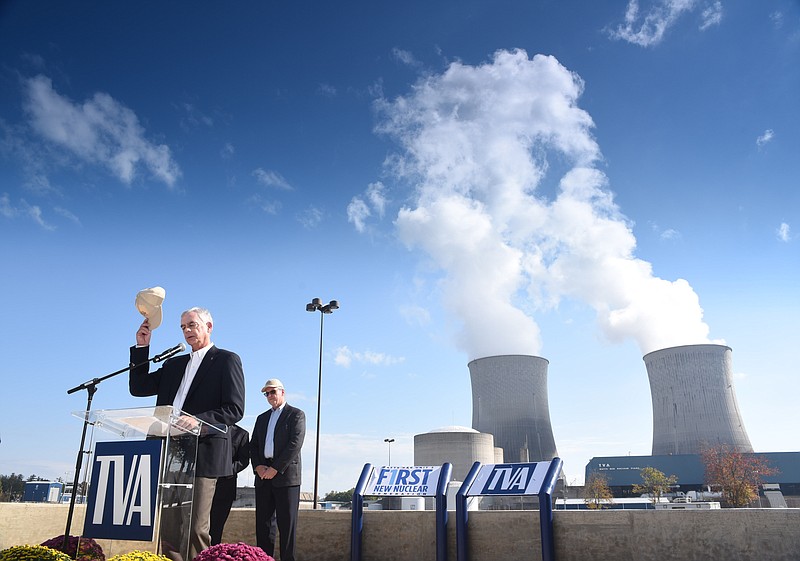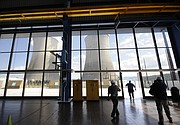SPRING CITY, Tenn. - America's first new nuclear reactor of the 21st century was declared complete on Wednesday, helping the Tennessee Valley Authority to meet nearly half of its electricity demand with carbon-free generation as temperatures soared to a near record high on Wednesday.
The Tennessee Valley Authority completed the final power ascension tests and performance measures Wednesday morning to officially declare the Unit 2 reactor at the Watts Bar Nuclear Power Plant a commercial power plant, bringing the $4.7 billion expense of finishing the plant over the past four years into TVA's rate base for the first time.
The achievement marks the end of a 43-year effort to finish what may be the last nuclear plant of its type built in the Tennessee Valley.
Although the plant ended up taking longer and being more expensive than originally forecast, TVA President Bill Johnson said the addition of the Unit 2 reactor will not push up electric rates beyond the small rate increases TVA has already been making each year. The new reactor also will provide TVA a carbon-free, reliable source of baseload power for at least the next 40 years, if not longer, Johnson said.
"This is a great day for TVA and for the people of the Tennessee Valley," the TVA CEO said during a ceremony at the twin-reactor plant on Wednesday. "We had hoped that this unit would be done quicker, but it's such a high quality, reliable machine that I'm happy about the way it turned out. Forty years from now, I'm confident people will look back and realize how valuable this plant is and why it was the right decision to finish it."
In the short term, TVA's newest reactor will have slightly higher incremental costs for the power it generates than what TVA now pays even after TVA wrote off some of its initial investment at Watts Bar going back to its start in 1973. But with relatively cheap nuclear fuel costs and the synergy of operating two reactors on the same site, TVA officials insist that the new Watts Bar unit should ultimately help lower TVA costs.
"Declaring this a commercial plant is the capstone for this project and represents a significant milestone not only for TVA but for the nuclear industry and the nation as well," said Joe Grimes, TVA's executive vice president and chief nuclear officer. "As we seek to produce even cleaner energy, zero-emissions nuclear power is key to helping us achieve ambitious climate goals. The team that built this plant took the time necessary to do it right to make sure that Unit 2 serves the Tennessee Valley for decades to come."
Watts Bar Unit 2 has already provided more than 500 million kilowatthours during testing since the reactor first began generating power in May. Wednesday's milestone followed three weeks of continuous full-power generation by the new reactor following a series of power ascension tests through the summer.
TVA now has seven nuclear reactors - three at Browns Ferry in Alabama and two each at Sequoyah near Soddy-Daisy and at Watts Bar here. Six of those were operating Wednesday during the unseasonably warm fall day, helping to supply nearly 40 percent of TVA's power. Combined with the power from TVA's 29 hydroelectric dams and other purchased power from solar and wind sources, about half of TVA's electricity generation now comes from carbon-free sources.
U.S. Sen. Lamar Alexander, the most ardent promoter of nuclear power in the U.S. Senate, applauded TVA for finishing Watts Bar Unit 2 and adding the 100th commercial nuclear reactor in the United States.
"This is the country's first new nuclear reactor completed in the 21st Century, and it will provide cheap, carbon-free and reliable electricity to the Tennessee Valley," said Alexander, who has urged utilities to build another 100 new nuclear reactors. "Congress, states, federal agencies, and the Nuclear Regulatory Commission should work more closely with utilities to maintain our existing reactors when it is safe to do so and build more reactors, because without nuclear power - it will be much harder to reduce carbon emissions that contribute to climate change."
But TVA, which once planned to erect 17 nuclear reactors, has given up on 10 of those and has no plans on the drawing board for any additional nuclear plants for the first time in a half century.
TVA's power demand, which was once growing nearly 7 percent a year, has virtually stalled as energy-efficient appliances, furnaces and machines use less electricity and a growing number of homes and businesses generate some or all of their own power from solar or wind sources.
"Our power demand is not growing, but this nuclear unit will help substitute for some of the older coal units we have shut down and give us a clean, reliable source of power for many decades ahead," Johnson said.
TVA cut several hundred jobs from its nuclear power program in the fiscal year that ended Sept. 30, Grimes said. Although TVA is still studying the possibility of building small modular reactors in Oak Ridge, TVA has no plans for any more major nuclear power plants for at least 20 years and the utility will sell its nearly finished Bellefonte nuclear power plant in Alabama next month.
Mike Skaggs, the 30-year nuclear engineer who oversaw the completion of Watts Bar Unit 2 over the past four years, said finishing the Watts Bar unit "was the most difficult, complex project I've every worked on."
Skaggs took over the project four years ago when he said it was about 40 percent complete. Following the 2011 nuclear accident at the Fukushima plant in Japan, TVA had to build a power backup building and make other dam repairs to help Watts Bar meet even stricter standards adopted by nuclear regulators to prevent Fukushima-style disaster at a U.S. plant.
Skaggs said the Fukushima changes added about $200 million to the cost of the Unit 2 reactor. But those changes and other upgrades make Watts Bar the most advanced of America's fleet of 100 nuclear units, even though it was originally designed a half century ago.
"It's as good of a plant as we have in the United States," Skaggs said.
TVA began building the Watts Bar Nuclear Plant here in 1973. The first reactor was nearing completion in the 1980s when safety concerns were raised by whistle blowers at the plant and by an internal nuclear review group.
In response to such concerns and new regulations developed after the 1979 accident at the Three Mile Island nuclear plant, TVA rechecked and revamped many of the electrical lines and safety systems before ultimately started the first reactor here in 1996. The Unit 1 reactor at Watts Bar was the last nuclear reactor to be built in the U.S. prior to the Unit 2 startup here.
Each of the reactors at the Watts Bar plant are capable of generating 1,150 megawatts of electricity, or enough power for about two cities the size of Chattanooga.
Contact Dave Flessner at dflessner@timesfreepress.com or at 423-757-6340.

